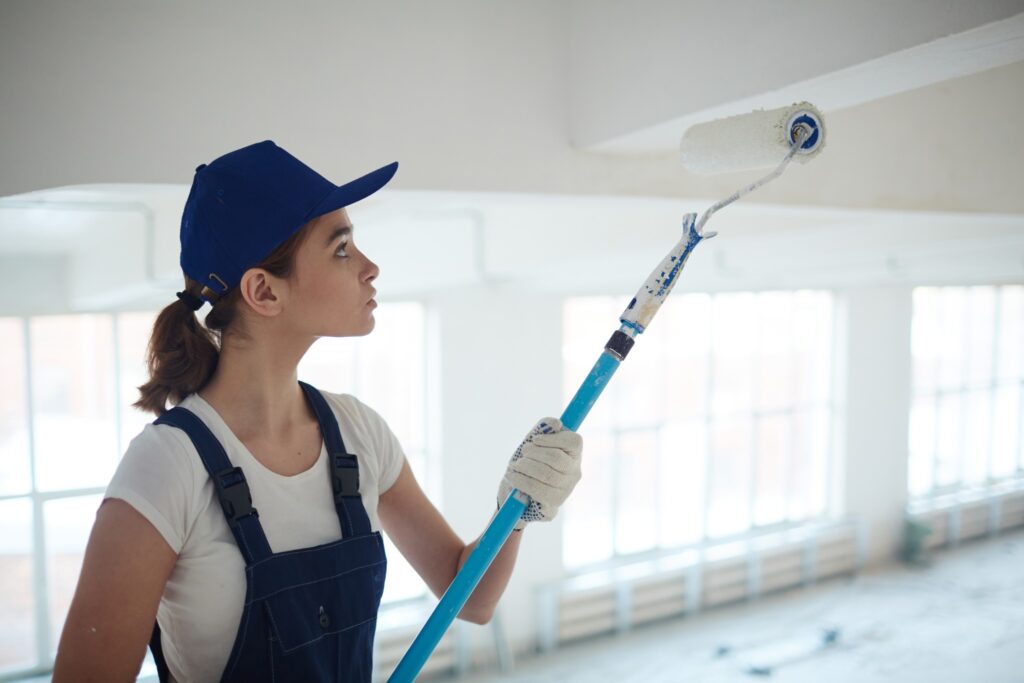
When it comes to transforming your living space with a fresh coat of paint, the choices can be overwhelming. Choosing paint colors is hard enough, but you also need to consider the right finish. Walls, ceilings, and trim each have unique characteristics that require specific types of paint for the best results. Choosing the right paint for different surfaces will ensure a high-quality and lasting finish.
Bella Vista is in the business of making your home look great. But even more importantly, we’re in the business of protecting your home’s value and integrity through expert workmanship. From color selection through the finishing touches, our team is here to help. We are the go-to professional paint contractors for Vancouver, WA, Portland, OR, and surrounding areas. Contact us today for your free consultation and estimate.
A Quick Look at Paint Sheens
Until you had to start adulting and making decisions about home improvements, you probably didn’t think much about paint sheens. A paint’s sheen is determined by how much light it reflects. Basically, it’s like a shininess ranking.
From least shiny to most, here are your common paint sheens:
- Flat or Matte – no shine
- Eggshell
- Satin
- Semi-gloss
- High-gloss – all shine

The shinier the paint, the easier it is to clean and the more durable it is. The duller the paint, the more it can hide imperfections in the walls and the more coverage you’ll get from each gallon.
Choosing the Right Paint for Different Surfaces
Before diving into paint options, it’s necessary to understand the characteristics of the surfaces you’ll be working on for your project. Whether you DIY it or hire a professional painter, it’s critical to pick the right finish.
Walls, ceilings, and trim have different textures, exposure levels, and purposes, giving each one unique painting requirements. The same is true for the rooms in your home. Your bathrooms will need a different sheen than your office or bedroom.
Each finish has a purpose in your home’s interior paint job, so let’s take a look at where they belong.
The Ideal Paint for Walls
Walls are the largest surface area in any room, and their finish sets the tone for the entire space. For walls, it’s best to use a water-based latex paint. Latex paint is durable, dries quickly, and is easy to clean, making it an ideal choice for high-traffic areas.

Choosing the right sheen will mostly depend on the room’s use and conditions. Here is a quick wall paint cheat sheet that works for most homes:
- Kitchen and Bathrooms: Satin or eggshell to protect against moisture and spills and for easy clean-up.
- Family Room and Living Room: Satin or eggshell to create a cozier atmosphere without so much reflection. If you have young children or pets, opt for satin for the durability factor.
- Dining Room: Satin or eggshell to allow for relatively easy cleanup if food or drinks spill. If you don’t have young children or want a more modern look, you could try a flat paint. It isn’t as durable but can give the aesthetic you want.
- Bedrooms: Eggshell or matte for a calm, relaxing vibe in the adults’ rooms. Bedroom walls don’t usually take the beating that other rooms do, so you can generally get away with a lower shine. For kids’ rooms, consider an eggshell or satin sheen for durability and easier cleaning.
- Hallways: Satin or eggshell for durability and ease of cleaning. Hallway walls get lots of dirty fingers, crashing toys, and other impacts that can take a toll on a paint job.
Choosing the Right Ceiling Paint

Painting a ceiling requires a different approach than walls. Ceilings often have imperfections and are prone to shadows, so a flat or matte finish is typically the best choice. Flat finishes help to hide imperfections and evenly distribute light throughout the room.
If your ceiling isn’t highly textured, opt for a paint labeled specifically for ceilings to ensure the right consistency and coverage. Ceiling paints are generally thicker, so they are less likely to drip all over you during your project. For spaces with high texture, however, a flat wall paint is the better choice.
For plaster or stucco ceilings, be sure to choose a paint for use on those materials. Stained wood ceilings will require an oil-based paint.
Trim and Molding Considerations
Trim, including baseboards, crown molding, and door frames, adds architectural interest to a room. When painting trim, a semi-gloss or high-gloss finish is the preferred choice. These finishes are easy to clean and provide a smooth, durable surface that can withstand wear and tear.
Bella Vista Gives Your Home the Love It Deserves
Choosing the right paint for different surfaces is a key step in achieving a professional and polished look for your home. Whether you’re taking on a DIY project or hiring a professional house painter like Bella Vista, choosing the right paint for different surfaces is crucial.
The Bella Vista team is honored to serve so many home and business owners in the Pacific Northwest. Our experienced crews treat your property with the utmost care and respect as we give it the paint job of your dreams. Reach out today to get an estimate and secure your slot on our calendar.